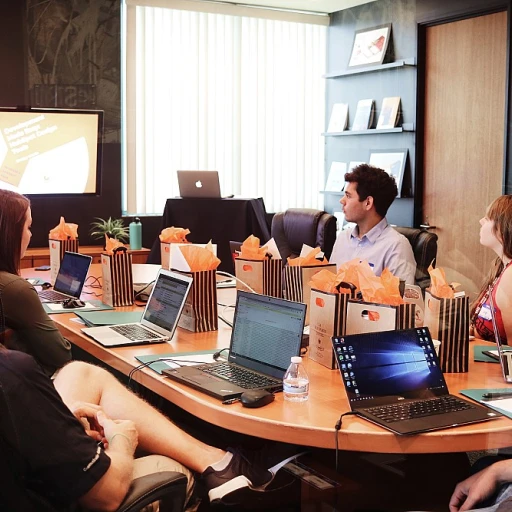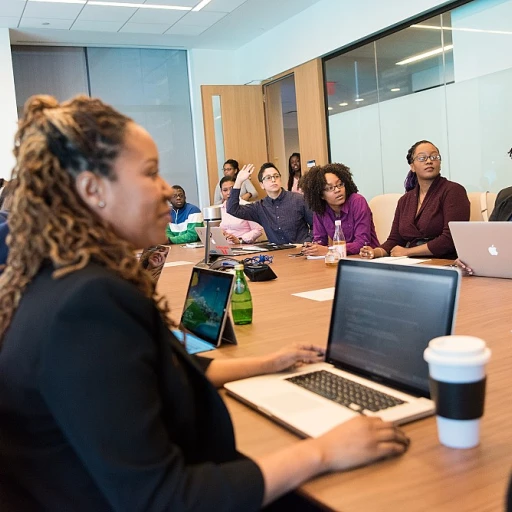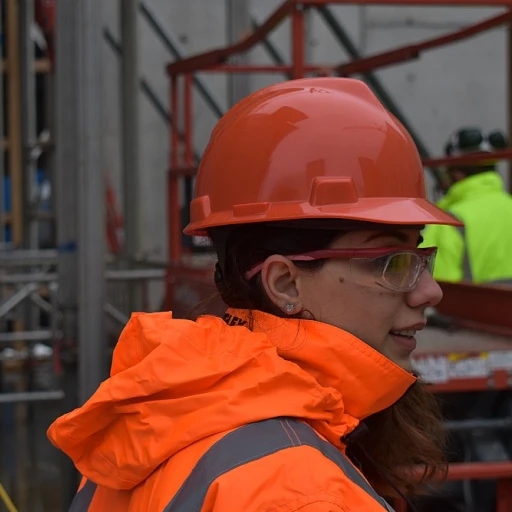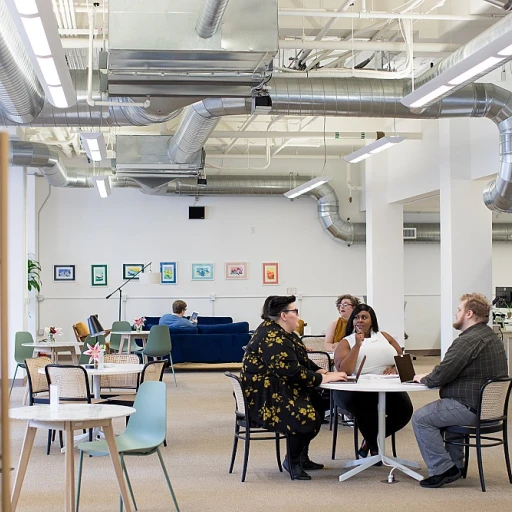
Understanding Cross-Departmental Reskilling
Exploring the Essence of Cross-Departmental Reskilling
In today's fast-paced business landscape, cross-departmental reskilling is emerging as a crucial strategy for organizations aiming to foster innovation and enhance cross-functional collaboration. The hallmark of effective cross-departmental reskilling involves breaking down silos and promoting a culture where employees can transition smoothly between departments, leveraging shared knowledge and skills across teams.
This journey begins with a clear understanding of what reskilling entails within a multi-departmental context. It is not merely about acquiring technical expertise but also about enhancing soft skills such as communication, customer service, and problem solving. These competencies become critical as employees engage in cross-team projects, ensuring seamless integration and collaboration.
Successful cross-departmental reskilling enhances collaborative problem solving and cross-team decision making. By building a workforce that is adaptable, companies can better align their resources to anticipate market demands and zmarketplace.
Emphasizing open communication and knowledge sharing, organizations can create an environment where departmental collaboration thrives. This, in turn, boosts team members' motivation and employee engagement.
To delve deeper into creating a reliable strategy for this kind of reskilling, businesses can look at how to identify the skills that can be effectively transferred across functional teams. For practical insights and strategies that reinforce workforce adaptability, businesses can refer to enhancing workforce efficiency for an in-depth guide.
Identifying Transferable Skills
Spotting Skills that Cross Boundaries
In the realm of cross-departmental reskilling, identifying transferable skills is paramount. These are capabilities that employees possess, which can be applied across various roles and functions within the organization. Recognizing such skills allows companies to leverage their human capital efficiently and ensure they are aligned with overall organizational goals.
At the core of this process is cultivating an enterprise mindset. Employees and management alike need to appreciate that the value of a particular skill isn't confined to one department. Instead, it's how a skill contributes to the broader picture and collaborative efforts across teams.
The Role of Open Communication
Open communication plays a vital role in identifying these skills. Regular cross team and cross departmental discussions foster an environment where employees feel comfortable sharing their abilities. This not only enhances team collaboration but also ensures that the skills that exist within the company are recognized and can be applied in cross functional collaborations. Marketing, customer service, and product development, for instance, can benefit significantly from functional collaboration and knowledge sharing.
Utilizing Internal Tools
Effective cross departmental collaboration often relies on the right tools. These tools assist in the seamless integration of skills across departments and support communication. From project management platforms to collaborative software, having the right resources in place ensures that valuable skills are utilized effectively and goals are met.
Identifying transferable skills and their application across departments is a cornerstone of successful reskilling efforts. It can lead to innovative problem solving and efficient decision making, helping organizations remain competitive and adaptive in a constantly changing business environment.
Challenges in Cross-Departmental Reskilling
Overcoming Barriers in Cross-Departmental Reskilling
Embarking on a journey of cross-departmental reskilling is not without its hurdles. Organizations often face a variety of challenges when trying to foster a culture of effective cross-functional collaboration. Understanding these challenges is crucial for developing strategies that promote seamless transitions across departments.
Communication and Collaboration Challenges
One of the primary obstacles is the lack of open communication and collaboration between teams. Departments often operate in silos, which can hinder the flow of information and impede knowledge sharing. This disconnect can lead to misunderstandings and misaligned goals, making it difficult for employees to adapt to new roles in different departments.
Resistance to Change
Resistance to change is another significant barrier. Employees may feel apprehensive about moving into unfamiliar territory, fearing that their current skills may not be applicable in a new department. This fear can be mitigated by identifying transferable skills that are valuable across various functions.
Resource Allocation and Support
Effective reskilling requires adequate resources and support from management. Without proper tools and resources, employees may struggle to acquire the necessary skills to succeed in their new roles. Organizations must invest in training programs and provide access to learning platforms to facilitate this transition.
Aligning Goals Across Departments
Aligning departmental goals is essential for successful cross-departmental reskilling. When teams work towards shared objectives, it fosters a sense of unity and purpose. This alignment can be achieved through regular meetings and collaborative project management, ensuring that all team members are on the same page.
By addressing these challenges head-on, companies can create a more adaptable and versatile workforce, ready to tackle the demands of an ever-evolving business landscape.
Creating a Reskilling Roadmap
Mapping Out the Reskilling Journey
Embarking on cross-departmental reskilling within an organization requires a structured approach. Here's a roadmap to guide employees and teams through this transformative journey.- Assess Current Skills and Set Goals: Begin by identifying the current skill set of employees. This crucial step allows functional teams to determine gaps and create personalized reskilling objectives aligned with organizational goals.
- Create Collaborative Milestones: Establish clear milestones within the reskilling framework. Promote functional collaboration by setting shared goals that involve cross-departmental collaboration. Encourage team members from different departments to participate actively, enhancing shared accountability and collective success.
- Develop a Personalized Learning Plan: Customize learning experiences tailored to individual and departmental needs. Facilitating open communication between departments ensures that employees receive relevant training, aiding in effective cross-functional development.
- Integrate Resources and Tools: Provide access to necessary tools and resources that aid in skill acquisition. Organizations can promote knowledge sharing and team collaboration by utilizing project management tools, video conferencing platforms, and online learning modules.
- Encourage Continuous Feedback and Reflection: Incorporate feedback loops to evaluate the effectiveness of the reskilling process. Foster an open communication environment where teams work collaboratively to refine strategies, solve problems, and adapt to changing business landscapes.
Tools and Resources for Effective Reskilling
Empowering Cross-Departmental Collaboration through Tools
In today’s fast-paced organizational climate, effective cross-departmental reskilling hinges heavily on the right tools and resources. Facilitating a smooth transition across teams involves more than just new training curricula; it requires digital platforms that encourage seamless communication and collaborative efforts.
One of the fundamental aspects of reskilling lies in how departments work collectively to achieve shared goals. Tools such as project management software allow for the tracking of progress and open communication ensuring team members from various departmental backgrounds are on the same page. Platforms like Trello, Asana, or Monday.com offer features that help in organizing cross-functional tasks, making it simpler for team members to visualize how their responsibilities connect with the broader company objectives.
Furthermore, knowledge-sharing platforms are essential in bridging the gap between departmental silos. Tools like Slack or Microsoft Teams enable not only real-time communication but also foster an environment where ideas can be exchanged freely. This functional collaboration encourages innovative problem solving and ensures that customer pain-points are addressed comprehensively, as insights are pooled from diverse departmental perspectives.
Nurturing a Culture of Learning and Flexibility
Effective cross-functional collaboration is strengthened by a cultural shift within the organization toward continuous learning and adaptability. Online learning environments such as Coursera or LinkedIn Learning offer a range of courses that can be tailored to the specific needs of the company, supporting the employees’ commitment to personal development and cross-departmental skills acquisition.
When departments embrace the collaborative elements of reskilling tools, it not only transforms individual skill sets but elevates team collaboration. Employees discover new approaches to communication and teamwork that bolster decision-making and drive success across functional teams. Consistently prioritizing these resources ensures that the organization remains agile and competitive, ready to navigate the dynamic demands of the market.
Success Stories: Real-World Applications
Real-World Success in Cross-Departmental Reskilling
In today's dynamic work environment, organizations are increasingly recognizing the value of cross-departmental reskilling. This approach not only enhances versatility but also fosters a culture of collaboration and innovation. Let's explore some real-world examples that highlight the impact of effective cross-departmental reskilling.
Enhancing Customer Service through Cross-Functional Teams
One notable example comes from a company that successfully improved its customer service by integrating marketing and customer support teams. By reskilling team members from both departments, the organization was able to create a more cohesive approach to addressing customer needs. This collaboration led to improved problem-solving capabilities and a more seamless customer experience.
Driving Innovation in Product Development
Another organization leveraged cross-departmental reskilling to boost its product development process. By encouraging knowledge sharing between engineering and marketing teams, the company was able to align its product goals with market demands more effectively. This functional collaboration not only accelerated product development but also enhanced the decision-making process, resulting in innovative solutions that met customer expectations.
Streamlining Project Management through Open Communication
Effective cross-departmental reskilling can also streamline project management. In one case, a company focused on improving communication between its project management and IT departments. By reskilling employees to understand both technical and managerial aspects, the organization achieved better alignment of project goals and more efficient execution. This open communication fostered a collaborative environment where team members could work together seamlessly.
Building a Culture of Shared Goals and Collaboration
Ultimately, the success of cross-departmental reskilling lies in building a culture where shared goals and collaboration are prioritized. Organizations that invest in reskilling initiatives often find that their teams work more effectively across departments, leading to enhanced organizational performance. By fostering a collaborative spirit, companies can navigate the complexities of modern work environments and achieve sustainable growth.












